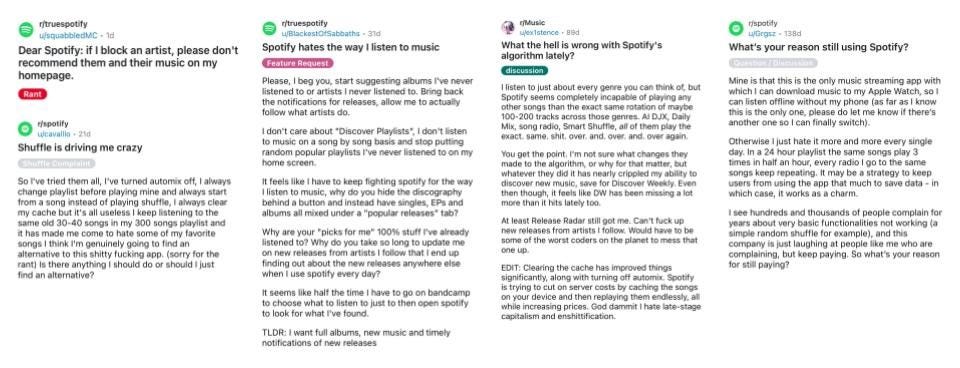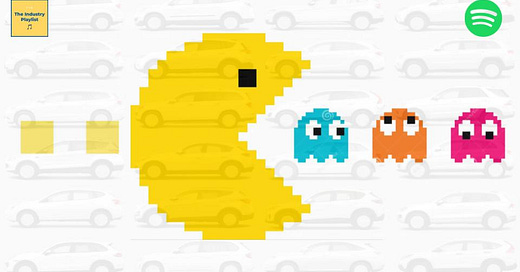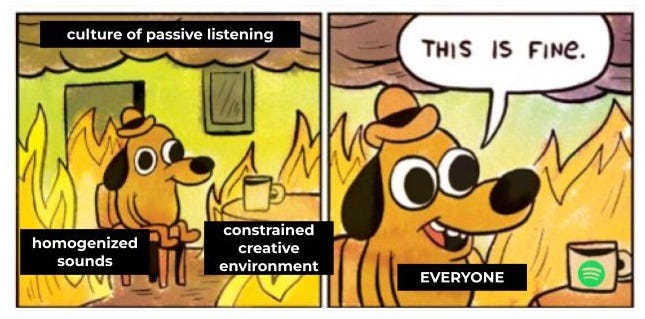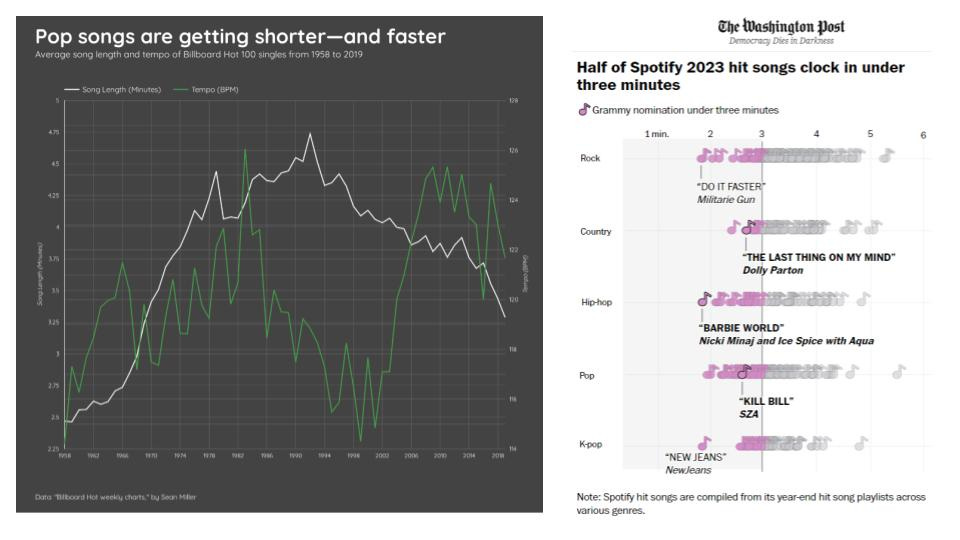Spotify's accruing cultural debt
Deep Dive 04 | The algorithmic wind tunnel effect in action
HMK called it.
Wait a minute, get it how you live it
Ten toes in when we standin' on business
I'm a big stepper, underground methods
Top-notch hoes get the most, not the lesser
Straight terror, product of your errors
Pushin' culture, baby, got that product you can't measure
Recently James Blake came out strongly against digital monopolies throttling his ability to reach fans, the ones he and every other artist cultivates through years of creating and sharing their art. Blake isn’t just venting—he’s sounding the alarm for an industry caught in the gears of profit-driven algorithms. And he’s right to.

Blake’s frustration points to a larger issue: music has shifted from being an expression of art to ‘content’ - something designed for virality and volume, with everything meticulously measured and optimized for consumption.
Frankly, the issue isn’t virality or volume—music has always thrived on viral breakout moments. The problem is that the efficiency of algorithmic push have made these moments feel mechanical, reducing them to fleeting trends with no depth or staying power.
Because culture isn’t something one can manufacture through efficiency and data (it’s something that evolves, often slowly and unpredictably), the dominance of algorithmic efficiency has replaced any other meaningful/analog ways of cultural emergence.
That’s why I believe artistry and culture goes beyond what’s ‘measurable’. They belong to the realm of magic, chance, and serendipity—things that can’t be engineered but must unfold organically.
But what happens when algorithmic efficiency takes over?
The cracks are visible beyond artists too. Music fans are also getting fed up. Reddit is full of rants about how Spotify’s algorithmic recommendations recycle the same old tracks, turning discovery into something akin to advertising.
Spotify has pushed new releases to me by artists I don’t even follow (I don’t follow Coldplay, but their new album was on my homepage?). My rant of Spotify’s features and usability will need a separate TIP post.

Just this month, Spotify Advertising came out with a Next GenZ Culture Trends report for the first time. Spotify seems to be slowly transforming from an ad-supported/subscription model to an advertising model and we have barely noticed.
The era of streaming and Spotify’s dominance
Spotify isn’t some buggy startup who you can give the benefit of doubt; it’s the most influential music platform of the modern era. It has reshaped how we consume, create, and discover music, and will continue to do so for the foreseeable future.
As the largest music company in the world (it’s founder Daniel Ek is now richer than any musician alive), Spotify holds immense power. Powerful enough to shape our cultural landscape for the years to come.
Spotify’s quest for growth and profitability (thanks late-stage capitalism) is incurring a ‘cultural debt’ by fundamentally altering the structures of music production, distribution and consumption. I call it the ‘algorithmic wind tunnel effect’.

Some are a direct consequence of Spotify’s platform design, payment structures and operational choices; and more are second order effects of Spotify’s disruption of the creative-commercial ecosystem of music.
All of these combined (‘commodification of music’ as shorthand) in service of efficiency, profit and algorithmic optimization is resulting in a significant loss of cultural value and diversity.
This isn’t all Spotify’s fault. In fact, Spotify is more like the biggest beneficiary of a broader shift. Call it the technification of entertainment—an era where algorithms and data run the show, and creativity bends to the will of commerce.
Spotify just happens to be the face of this transformation because it’s the one cashing in the most from it. As the biggest player in the game, Spotify holds the most responsibility for paying back a cultural debt that’s piling up faster than we realize.
If we’re not careful, this debt will leave us with a music landscape that’s efficient but utterly forgettable.
Both artists and listeners feel the weight of this debt - it manifests in a constrained creative environment, homogenized sounds, and a culture of passive-listening - reducing the depth and richness of our musical experiences. In the end, this shift eats away at the creative core of the music industry, sacrificing soul for scale.
Let’s dive deeper.
The rise of music as content
Music today has shifted from being an art form to a commodity—content optimized for virality and volume rather than artistry or longevity. Streaming platforms like Spotify have accelerated this transformation by breaking music into smaller, marketable pieces designed for constant consumption.
Albums, once the pinnacle of artistic storytelling, are becoming relics. With playlists and algorithms ruling the landscape, artists are incentivized to release singles frequently, each one offering a quick shot at visibility and streams.
The idea of crafting a cohesive album that unfolds over time now seems impractical, and as a result, the space for long-form storytelling is shrinking. What used to be a journey through an artist’s vision is now splintered into standalone tracks, reducing both the creative depth and cultural significance albums once provided.
Playlists have become the dominant way we discover and consume music, shifting the focus from creativity to contextual fit. Instead of making bold artistic statements, artists now aim to slot their music into mood-based playlists—tracks designed to complement workouts, study sessions, or relaxation time. Music becomes a tool, something to blend into the background rather than engage the listener emotionally or intellectually. This creates a culture of passive consumption, where music is heard but not felt, reducing its ability to shape identity or provoke thought.
This shift also shapes how songs themselves are made. As algorithms favor tracks that hook listeners within seconds (Spotify counts a stream if a song is played for 30 seconds), songs are getting shorter and more formulaic.
The pressure to impress on a listener to complete 30 seconds leaves little room for experimentation, slow builds, or complex arrangements. Music becomes compressed—both literally, in track length, and figuratively, in creative expression. The need for efficiency replaces the space for risk-taking, reducing music to a predictable stream of bite-sized content.
What emerges is a musical landscape that serves the algorithms perfectly but leaves behind a shallower cultural footprint. Without the freedom to create at length, tell stories, or explore new sounds, artists are constrained by the logic of playlists and streams.
As music adapts to these rules, the cultural cost becomes unavoidable: the emotional journeys, creative risks, and meaningful connections that once defined the art form are slipping away. Music may be more accessible than ever, but it is just as quickly forgotten.
Algorithms are the new A&R
Algorithms have quietly taken over the role once held by A&R scouts, shaping what music gets made, promoted, and heard. Where record labels used to take risks on new talent and innovative sounds, today’s algorithms are limiting the future to the past.
Spotify’s recommendation engine promotes music that aligns with established listening habits, encouraging mainstream genres that appeal to broad audiences. As these familiar styles get more exposure, niche, experimental, and non-Western music finds it harder to break through, creating a loop where safe sounds rise to the top and more unconventional work struggles to find a space.
Let’s also not forget that music used to be about sparking discussion—something that people actually engaged with beyond just listening. Music journalism (album reviews, interviews with artists, think pieces that dissected the cultural meaning behind a record) added layers of context and depth to the music. Just as music has been reduced to mere content, music journalism is either dead or diluted into clickbait. Publications are struggling to survive, and the thoughtful pieces that once connected us more deeply to the art form are disappearing. Critics used to shape what people listened to—now algorithms do the job instead.
The growing reliance on data has further changed the way music is made. With streaming metrics guiding decisions, artists and labels tend to follow patterns that have already proven successful. While data can help artists understand their audience, it also nudges them toward familiar formulas, leaving less room for experimentation. Over time, this can lead to a more uniform musical landscape, where risk-taking becomes the exception rather than the norm.
This isn’t about a sudden collapse in creativity—great music is still coming out. But as algorithms and data shape the industry, what gets heard narrows, and how music evolves constricts.
The focus on what works now makes it harder for artists to push boundaries and for listeners to encounter the unexpected. Creativity isn’t gone, but it’s bending to fit the platform’s logic, slowly shrinking the music world’s sense of possibility.
Uber-ization of independent artists
The rise of streaming was supposed to be a revolution for independent musicians. With platforms like Spotify, the dream was simple: anyone could upload their music, find an audience, and make a living. But in practice, this promise looks a lot less like the golden age of creativity and a lot more like the gig economy.
Independent artists are caught in an endless grind, pumping out content just to stay visible, much like Uber drivers chasing rides to make rent.
The system rewards quantity over quality, and even the hardest-working musicians struggle to break even. It’s a high-output, low-reward loop, and Spotify’s payout system is the perfect emblem of this shift.
The economic structure of streaming also creates a widening gap between top-tier stars and everyone else. This erosion of the music industry’s “middle class” comes at a steep cultural cost. In the past, artists at every level—mainstream, mid-tier, and underground—contributed to a rich, diverse ecosystem. Now, as the industry becomes increasingly polarized, with a handful of stars at the top and millions of struggling musicians below, the variety of voices that once defined music culture will start to thin out.
Spotify’s democratization of music may sound revolutionary, but the gatekeepers never really went away—they’ve just been replaced by algorithms. Getting lucky with a playlist placement can boost an artist temporarily, but the system doesn’t offer stability. Much like a gig worker clocking endless miles, independent musicians have to keep releasing music just to stay in the game.
The shift to streaming isn’t just about a change in technology—it’s a change in how musicians live and work. The focus on volume over artistry leaves little room for musicians to develop their craft. Instead, they’re locked in a system that demands more, faster. Creativity becomes a grind—something to keep up with, not something to pursue.
Music as background noise
We’re not really listening anymore, are we?
Streaming has made music easy to consume, but also easy to ignore. What was once a source of deep engagement, has become background noise (or radio?) in the streaming era—something to fill the silence while we work, cook, or scroll through Instagram. Music, which used to demand attention, has become a utility—a tool to fit into our routines, not an experience to partake in.
Songs are isolated products; albums, once artistic narratives, are replaced by playlists devoid of artistic context. Such shifts have flattened the emotional range of music.
Tracks are optimized to be non-intrusive, blending smoothly into playlists rather than making bold statements. While seamless listening has its perks, it diminishes music’s ability to inspire or provoke reflection. As the emotional highs and lows are smoothed out, music’s role in shaping personal identity and cultural meaning quietly erodes.
The more we treat music as background noise, the more creative risks go unnoticed. Passive listening makes it harder to appreciate experimentation or bold ideas. The cultural debt here isn’t just that music has become more disposable—it’s that we’re losing the connection to what made it meaningful in the first place.
The quiet erosion of nostalgia
We’re quietly heading into a future where nostalgia won’t carry the same cultural weight it once did, and we might not fully grasp the consequences until it’s too late.
Think about it: I still remember my first cassette, my first CD—but not my first Spotify download. (since you asked, it was Saathiya movie album (cassette), and Linkin Park’s Meteora album (CD)).
Most of the songs I sing along to today are ones I discovered in the pre-streaming era. For many of us, music memories are rooted in physical media or live experiences—tangible moments that shaped our connection to the art. But in today’s world of streaming, music consumption is increasingly personalized, passive, and ephemeral, creating fewer of those lasting emotional touchpoints.
The way we interact with music has changed fundamentally. Independent and isolated consumption on streaming platforms has taken the place of social discovery at live shows and grassroots venues. Listeners rarely stumble upon new acts in intimate settings where real fan connections are forged.
This shift has deeper implications for fandom and cultural transmission. Listeners today are being trained by algorithms to expect personalization, which makes them less open to unfamiliar sounds or challenging genres. Risk-averse consumers stick to what feels familiar, making it harder for new artists to break through and build sustainable careers.
Right now, the music industry is cashing in on nostalgia. Reissues, reunion tours, and catalog sales are raking in millions, but this mass nostalgia probably won’t last forever. Kids today aren’t developing the same emotional connection to music that earlier generations did.
The anonymous star phenomenon—where algorithms boost nameless, faceless tracks—only accelerates this trend. And without the shared experiences that once anchored fandoms, future generations will have fewer musical memories to look back on.
“There will be no nostalgia in the future if the present is not properly tended to”
- The Guardian
Nostalgia relies on the moments we create today—those experiences that live on in our minds and become cultural touchstones down the road. The music industry may thrive on nostalgia now, but if the current trends persist, the emotional connection needed to fuel future nostalgia will slowly erode—leaving nothing for the next generation to reminisce about.
The revolution that is locking us in
Spotify wowed me back in 2015, but nearly a decade later, I’m frustrated. Many listeners feel stuck, trapped by high switching costs—the whole “you can always leave” argument feels disingenuous.
Sure, if Spotify hadn’t done it, someone else would have. But that doesn’t change the fact that what’s happening is culturally erosive, and we deserve better. Spotify has become the biggest beneficiary of these shifts, and with that success must come the responsibility to face the music.
The algorithmic wind tunnel effect—a system that feeds us what’s familiar, encourages conformity, and drowns out new, experimental sounds—is getting stronger. The longer this loop spins, the harder it becomes for creative risks to break through, and the deeper the cultural void grows.
AI music might soon reshape the industry, but the real problems are already here. Spotify has normalized passive consumption, shrunk creative risk, and trained us to settle for personalization over discovery.
The result? A system that extracts value from music while giving little back in return.
This cultural debt is piling up, and if it isn’t addressed, we’ll wake up in a world where music feels shallow—where we struggle to remember what made it meaningful in the first place.
“Art is how we decorate space, music is how we decorate time.” - Jean-Michel Basquiat
PS: If you’re an artist navigating the challenges of breaking free from streaming's grip and seeking new ways to grow your revenue, we want to hear from you. Ping me on rohit[at]undertheradar[dot]in.
That was a mammoth post, especially with a month-long gap due to an evolving family health situation. I’ll do my best to get back to posting every week, but we’ll see how things go.
Thanks for your patience,
Rohit









